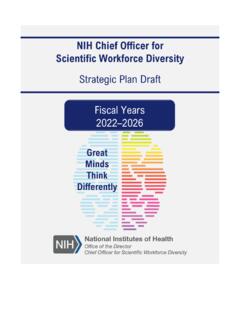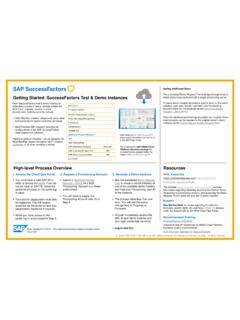Transcription of NIH WORKFORCE COVID-19 IMPACT SURVEY
1 NIH WORKFORCE . COVID-19 . IMPACT SURVEY . Executive Summary of the IMPACT of the COVID-19 Pandemic on the NIH WORKFORCE NOVEMBER 2020. Prepared for the NIH Chief Officer for Scientific WORKFORCE Diversity Prepared by ICF Next NIH WORKFORCE COVID-19 . IMPACT SURVEY . BACKGROUND ..1. Methodology ..1. SURVEY RESULTS ..2. Respondent Caretaking and Household NIH Cares about Caretaking ..3. Experience During Maximum Telework ..4. Job Productivity and Satisfaction ..6. Mental Health ..7. Support from NIH ..8. Return to Physical Workplaces ..9. Perceived Implications for Career Trajectory ..10. CLOSING ..11. Fostering Productivity ..11. NIH Communications and Support ..11. Fostering Connection ..12. Return to Work ..12. REFERENCES ..13. APPENDIX A.
2 Respondent Demographics ..14. APPENDIX B. Extramural and Intramural Program Results ..15. Experience During Maximum Telework ..15. Job Productivity and Satisfaction ..15. Perceived Implications for Career Trajectory ..16. i NIH WORKFORCE COVID-19 IMPACT SURVEY BACKGROUND. The global outbreak of severe acute respiratory syndrome coronavirus 2, which causes coronavirus disease ( COVID-19 ), has substantially altered daily life for individuals in the United States and around the world. As with many industries worldwide, both the pandemic and the measures to mitigate its IMPACT have greatly affected the scientific WORKFORCE . At the National Institutes of Health (NIH), members of the WORKFORCE have experienced a transition to virtual workspaces, unanticipated caretaking responsibilities, social distancing restrictions on biomedical labs, and other potential disruptions.
3 With these unprecedented changes comes a stark reminder that stressful situations often disproportionately affect groups underrepresented in the scientific WORKFORCE . Scientists have observed heightened COVID-19 infection and mortality rates among certain racial or ethnic groups, including African Americans, Hispanics/Latinos, and American Indians/Alaska Natives (CDC, 2020; Egbert, 2020; Garg et al., 2020). The literature demonstrates that these health disparities may have far-reaching consequences beyond health and can IMPACT other aspects of work and family life. Evidence also suggests that the pandemic may have negative effects on the productivity and professional trajectories of women, due to unanticipated and intensive child and elder care responsibilities (Flaherty, 2020), and of individuals with disabilities, due to intermittent lack of access to necessary medical care or supports (Pulrang, 2020).
4 To assess the IMPACT of the COVID-19 pandemic on the NIH WORKFORCE across Institutes, Centers, and Offices (ICOs) and to identify potential implications on diverse groups in the scientific WORKFORCE , the NIH Scientific WORKFORCE Diversity (SWD) Office fielded the NIH WORKFORCE COVID-19 IMPACT SURVEY in July 2020. Methodology SWD contracted the consulting firm Deloitte to develop, field, and analyze the SURVEY . The NIH SURVEY Development Group and a SURVEY Objectives team from Deloitte's SURVEY Research and analytics Center developed the SURVEY measures. 1. Understand the IMPACT of COVID-19 . DATA COLLECTION PERIOD: The SURVEY was administered on the NIH WORKFORCE (Note: Objective from July 14 to July 28, 2020. 1 is the focus of this Executive POPULATION: Invitations were sent to NIH federal staff, Summary).
5 Students and trainees, postdoctoral researchers, volunteers, and contractors (if given permission by their individual 2. Assess the IMPACT of COVID-19 on entities to participate). populations underrepresented in the scientific WORKFORCE MEDIUM: The 15- to 20-minute online SURVEY was administered via a unique email link. Individuals responded 3. Identify groups that may be newly to the SURVEY using a smartphone, tablet, or computer. vulnerable due to factors related to DATA PROTECTION: Deloitte removed personally COVID-19 . identifying information after data collection was completed. 4. Enable NIH to implement interventions NIH received aggregated and de-identified analyses from Deloitte to mitigate the IMPACT following the SURVEY to prevent possible re-identification of COVID-19 on its WORKFORCE of respondents.
6 Respondents could skip any question on the SURVEY . RESPONSE RATE: The Deloitte SURVEY team sent 33,013 email invitations to eligible members of the NIH. WORKFORCE . Of those, percent completed the SURVEY (n = 16,892). 1 NIH WORKFORCE COVID-19 IMPACT SURVEY RESULTS. This section features key findings from the NIH WORKFORCE COVID-19 IMPACT SURVEY . Unless stated otherwise, percentages refer to all individuals responding to a question, excluding those who skipped the question entirely. Question-level sample size (n) is depicted for each figure, denoting the number of respondents who answered the question. Respondent Characteristics Demographic characteristics for SURVEY respondents are provided in appendix A. With regard to work characteristics, percent of SURVEY respondents were NIH employees, percent were contractors, and percent were trainees (see figure 1).
7 Half of respondents ( ) identified their program area as intramural (see figure 2), and percent were located on the main NIH campus in Bethesda, Maryland (see figure 3). Figure 1. Employment Mechanism at NIH (n = 16,868) Figure 2. NIH Program Area 70% (n = 16,435). 60% Office of the Percentage of Respondents Director (NIH/ICO), Extramural, 50% 40%. 30%. 20%. 10% 0%. NIH Contractor Trainee* Non-NIH Volunteer Guest Intramural, employee Federal researcher employee * Trainees include post-baccalaureate students, special volunteers, predoctoral students, postdoctoral researchers, research fellows, and clinical fellows. Figure 3. Location of Primary NIH Workplace (n = 16,249). 60%. Percentage of Respondents 50%. 40%. 30% 20%. 10%. 0%.
8 Main NIH Elsewhere in Frederick, MD Research Baltimore, MD I primarily Rocky Other campus in Montgomery Triangle, NC teleworked Mountain Labs, Bethesda, MD County, MD prior to the MT. pandemic 2 NIH WORKFORCE COVID-19 IMPACT SURVEY Respondents answered questions regarding the type of work they perform at NIH. They could select more than one option, so response percentages may exceed 100 (see figure 4). Of those who responded, most indicated they perform research ( ), followed by administrative work ( ). Figure 4. Type of Work Performed at NIH (n = 16,760). 40%. Percentage of Respondents 35%. 30%. 25%. 20%. 15%. 10%. 5% 0%. Research* Administrative Other Operations**. Clinical care or Director/Leader Scientific core or Infrastructure support animal program support * Research included laboratory, clinical, epidemiologic, computational, or other.
9 Research**. ** Operations included finance, personnel, acquisitions, or safety. ** Scientific core or animal program research support included flow cytometry, sequencing, proteomics, animal care, or other. Caretaking and Household Risk Regarding caretaking, percent (n = 7,385) of respondents indicated having caretaking responsibilities for individuals who live in NIH Cares about Caretaking their household or family members who do not live with them. One in five respondents with caretaking responsibilities indicated their caretaking responsibilities have made their work responsibilities Caretaking responsibilities were a substantially more difficult to complete. Among respondents with crucial component of the NIH COVID- caretaking responsibilities, percent provide care for children 19 IMPACT SURVEY .
10 Here's why: ages 5 to 12, percent provide care for older adults,1 and With schools, childcare, and percent provide care for disabled individuals (respondents could daycare centers temporarily select more than one option). closed or at limited capacity, Regarding risk for COVID-19 , percent (n = 7,143) indicated that individuals had to assume someone in their household, including themselves, is considered at unexpected, full-time childcare in increased risk for severe illness due to COVID-19 (see figure 5). addition to work. Figure 5. Anyone in Household at Risk for Older adults may be at higher risk Severe COVID-19 Illness (n = 16,807) for serious COVID-19 infection and may therefore require more intensive caretaking ( , buying groceries) or care during illness.




